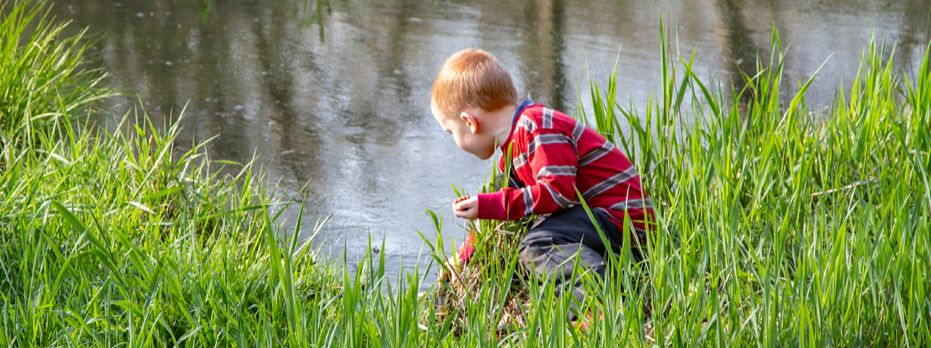We Need More Sticks and Grass! We Need More Beauty!
Connecting Kids to the Natural World
|
September 2009
“That’s an insect.”
“No, it’s not.”
“Yes, it is. It has six legs. Let me count. One, two, three, four, five, six.”
“What about those?” (Pointing to the head)
“Those are the feelers.”
Young children are great observers and wonderful debaters. The exchange above happened between two students in my combined kindergarten-first grade class at the Mission Hill School in the city of Boston. It was one of many exchanges between classmates as they attempted to classify the creatures we encountered during our fall nature study. The students argued respectfully, using evidence to support their claims. They questioned each others’ thinking and offered new questions to ponder. “What if an insect is missing a leg? Are they still insects if they only have five legs?” and “What about this centipede? It has 25 or 35 legs? What is it?” Observing closely, asking questions, gathering evidence, looking for answers and sharing ideas: these are vital skills for life. Not to mention the ability to stop and enjoy the beauty of the natural world.
One of my initial teaching resources was the small field book Sharing Nature with Children by Joseph Bharat Cornell. I remember using it for the first time while doing my student teaching. It is still a much-loved book in my collection. Since my first year in my own classroom, my students had Yertle, a Japanese box turtle to care for. Many times over the years, meeting that small, curious four-legged friend has helped ease a hesitant student’s transition from home to school. Twenty years later, that beloved Yertle continues to help students learn how to care for and connect with the natural world.
Although nature has always been a part of my work with children, in more recent years this emphasis has taken on new meaning. The modern, plugged-in world is forcing our young children to grow up too quickly. I’ve begun to use nature in a more deliberate way - as an effective antidote to screen-time. Helping children and families find ways to connect with nature is an exceptional way to reduce the negative effects of mainstream media. When I meet children who have been over-stimulated or over-saturated with the shiny, fast-paced images of the screen, I know that slowing them down and getting their hands dirty takes on new significance.
At our city school, we have found ways to cultivate nature. The community garden across the street provides a perfect first place for young children to practice gardening. They can see first-hand how different gardeners create and tend to their plots. Our custodian, an avid gardener, helped create inviting nooks in our school’s front yard. The small side yard has a grape arbor and most recently students have helped to build raised-bed gardens.
Many schools have no outdoor spaces, so finding ways to bring nature into the classroom becomes vital. One day I brought in some potted begonias from my garden at home. I wanted the students to help me pinch off the dead flowers, and then take care of the plants in our classroom over the upcoming weeks. What I didn’t anticipate was that the students would find live creatures, namely a baby snail and a small spider, among the pink flowers. The students decided to leave the baby snail on the plants. However, before I’d even realized it, some of them had decided to create a home for the spider. They’d found one of our bug jars and had added a small pumpkin, some leaves, some flowers and a stick. Someone even added a baseball card “for a bed”. They named the spider “Basil”. All of this led to a discussion about the word habitat. I asked, “What will it eat?” A few students offered to bring in flies from home. I asked, “What will it drink?” “Spiders drink the blood from the flies,” someone explained. “We think it will spin a web!” others added. The students were truly invested, curious and thoughtful - and we had real work to do to make sure this spider was cared for. Sometimes the unplanned learning moments are the best, and nature often offers the unexpected.
It’s difficult when “time on learning” has to be documented and connected to city or state mandated curriculum goals, with little breathing room for time spent outdoors, so it is helpful to remember that experiences with nature blend beautifully with early literacy lessons. Consider the following anecdotes:
“Can we dig for worms?” asked Ahmed. We were in the garden in front of the school. “That’s a good idea for another day,” I answered. “Today we are looking.” We also smelled the pink roses, rubbed the rough and smooth bark of the tree and heard the red cardinal. We saw a spider spinning a web, a butterfly flying, a bumble bee sitting on a flower, and many more wonderful things, all in our own front yard. After looking carefully, the children took time to draw and write in their garden journals. Amiel drew a picture of the pink rose and dictated, “I have a rose in my garden. The school garden has a rose, too.” Freddie loved the huge orange flower in the corner of the garden. He dictated, “Dear Daddy, This flower is one of my favorite flowers in the garden. We can go into the garden that’s in front of the school. Love, Freddie.” [Note to the reader, we did go back and dig for worms on another day, just as Ahmed had asked!]
And another day…
“Cool. I just read,” Ashley declared to herself. It was Friday afternoon and she had been writing in her Garden Journal. She was looking at some of the words in the meeting area that she needed for her journal (water, seed, sun, etc.) She decided to pick up our pointer and read the morning message. “Good Morning, Children. If you haven’t planted a bean seed, please do it today!” I smiled as I listened and watched. Ashley is in kindergarten and is already picking up the culture of literacy that is present in our classroom and at our school.
Nature also goes hand in hand with imagination. However, the value of free play has been diminished in many people’s eyes. Modern-day children often need a little nudge to see and feel the joy that can come from playing with nature. And modern-day parents often need a little nudge to let their children experience free play. To that end, I have begun collecting children’s books that celebrate imagination and nature. Two of my favorites are Roxaboxen by Alice McLerran and Gilberto and the Wind by Marie Hall Ets. In these two very different picture books, children get to see other children playing in thoughtful, natural and inviting ways. This is in stark contrast to the provocative images of children portrayed in mainstream media. After hearing these inviting stories read aloud, I have seen children incorporate the ideas in their outdoor play. According to Susan Linn in her book The Case for Make Believe: Saving Play in a Commercialized World: “The ability to play is central to our capacity to take risks, to experiment, to think critically, to act rather than react, to differentiate ourselves from our environment, and to make life meaningful.”
As a teacher, a parent and as a human being, I love that quote. I shared it with my classroom parents through my weekly newsletter to help underscore the value of time spent at play. As another way to honor children’s imaginations and their play in the natural world, I also wrote to parents about what the children were saying as they played:
Here are just a few snippets from a recent afternoon in the grassy area of the playground. Try to imagine yourself in their wonderful world!
Leaping from the boulder: “Garden gnomes are like fairies without wings.”
Figuring out who was going to be “it”: “Bubble gum, bubble gum in a dish! How many pieces do you wish?”
Building a house from rocks and sticks: “We need more sticks and grass! We need more beauty!”
And, “The worm died and went to heaven. Maybe someone else will move in, like a lady bug or a rolly polly.”
“Ms. Geralyn, come quick we found a bone!” And, “We need to clean this so we can look for fossils. I think there are dinosaur bones in here!”
Standing on the stone wall: “Roar! I’m King Kong!”
And from behind a hedge, “You can’t see me!”
Finding ways to keep the exploration of nature in the school day has never been harder. The steady stream of required yet unreliable assessments, together with scripted curricula that “teach to the test” leave less and less time for the craft of teaching and the vibrant world of emergent curriculum. As children are being lured by the mainstream media to grow up too quickly, we need to lead them back outside and offer them opportunities to play freely. Connecting children to the natural world has never been more necessary than it is today. In fact, it is essential.







